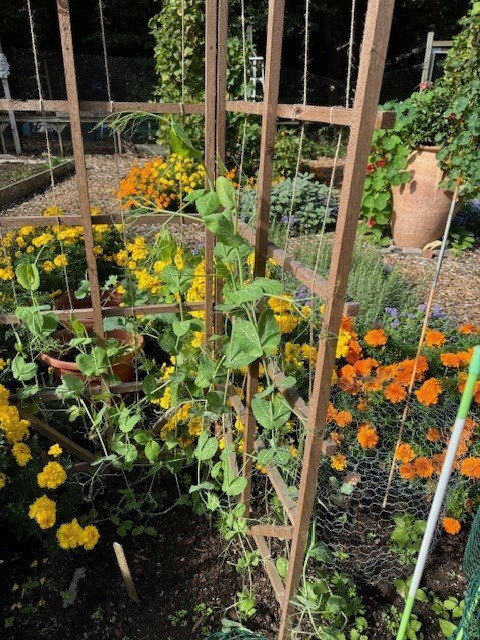The Renewed Veggie Gardens
The Teaching Vegetable Garden in August. Master Gardeners and Bartlett volunteers, Sandra Yates, Michele Kohari, Stephen Davis, and Rebecca Bleiman revamped and renewed the Teaching Vegetable Garden, and the results were AMAZING!
This year, a team of talented and dedicated volunteers took the lead in reviving the Teaching Vegetable Garden behind the greenhouse. The endeavor was so successful, that it became one of our most visited gardens this summer. We were so “wowed,” by the makeover, that we convinced the group to run a series of Veggie Garden workshops for our members and community. The mantra of the series was “if we can do it, anyone can,” something Sandra Yates, Michele Kohari, Stephen Davis, and Rebecca Beiman repeated often. While that may be a bit modest considering their skills and training, it remained the ethos of the workshop series, which was well attended with plans in place to continue next spring (if not sooner!)
An ounce of prevention…These gauze bags successfully kept critters at bay!
Now that the first year of the NEW Vegetable Garden is put to bed…pun intended, I asked the team to share their thoughts on the first year, and their plans for the upcoming growing season. The following offers a summary of her thoughts:
Preseason: A lot of roll-up-sleeves work, that included:
All weeds and invasive plants were removed from the beds and around the garden.
The soft fruit beds were cleaned and pruned to encourage new growth. The Bartlett’s soft fruit beds include currant, blueberry, blackberry, and raspberry bushes, as well as blackberry canes.
Planning and Planting: Much of what was planted this year were transplants unless otherwise noted. This was because there were several plants left from the Barltet plant sale that needed to get into the ground.
Tomatoes, eggplants, and peppers were started from seed in the greenhouse.
A Three Sisters garden of bush beans, butternut squash, and sweet corn was established. This was a modified version since crops were grown in rows rather than having the beans growing up the corn and the squash underneath.
A “Simon and Garfunkel” herb garden (parsley, sage, rosemary and thyme) was established.
Three varieties of heirloom pole beans, Trionfo Violetto, Kentucky Wonder, and Scarlet Emperor runner, were grown on wigwams that we constructed from bamboo poles cut from the bamboo collection on the grounds of the Arboretum.
Marigolds, salvia (pictured), zinnias, nasturtium, and scented geraniums were added to attract pollinators.
Experiment, Experiment, Experiment (translation: Have FUN!)
The gardeners’ experiments included growing potatoes, carrots, and peas in raised beds, which were quite successful, especially the potatoes and carrots.
Putting gauze bags on our tomatoes to save them from the critters who were stealing them (this worked really well).
Introducing flowers to the garden by edging the beds with marigolds and blue salvia. A bed of zinnias, pots of nasturtiums, and scented geraniums were also added. This might seem unusual or unnecessary but flowers attract pollinators to the garden and pollinators are good for crops.
Looking ahead:
Two rows of garlic plants were planted for harvest next year.
Cold frames were fashioned using donated skylights.
New Canaan High School interns, Luke and Kai, spent three weeks cleaning out the old veggie garden and helping the team set up the new one.
Next year the plan is to grow many plants from seed rather than relying on nursery-grown stock. According to Sandra, “this is so much more satisfying and allows us to experiment with different varieties.” There is also a plan to invest in a few cattle panels so vertical crops such as cucumbers, peas, squash, etc. can be grown in a space-saving manner, which also helps with plant health.
Other ideas include introducing crops from other countries, such as from the Caribbean, India, or Africa. All three agree that a crops should be chosen based on conditions (will it grow here?), taste (will you eat it?) and ease: let’s face it, you need a few wins to keep going. As you start planning for your vegetable garden, our team suggests these “easy-to-grow” plants.
Some crops that are easy to grow are the following, but remember to grow vegetables that you like to eat include lettuce, peas, tomatoes, beans (pole and bush varieties), kale, peppers





